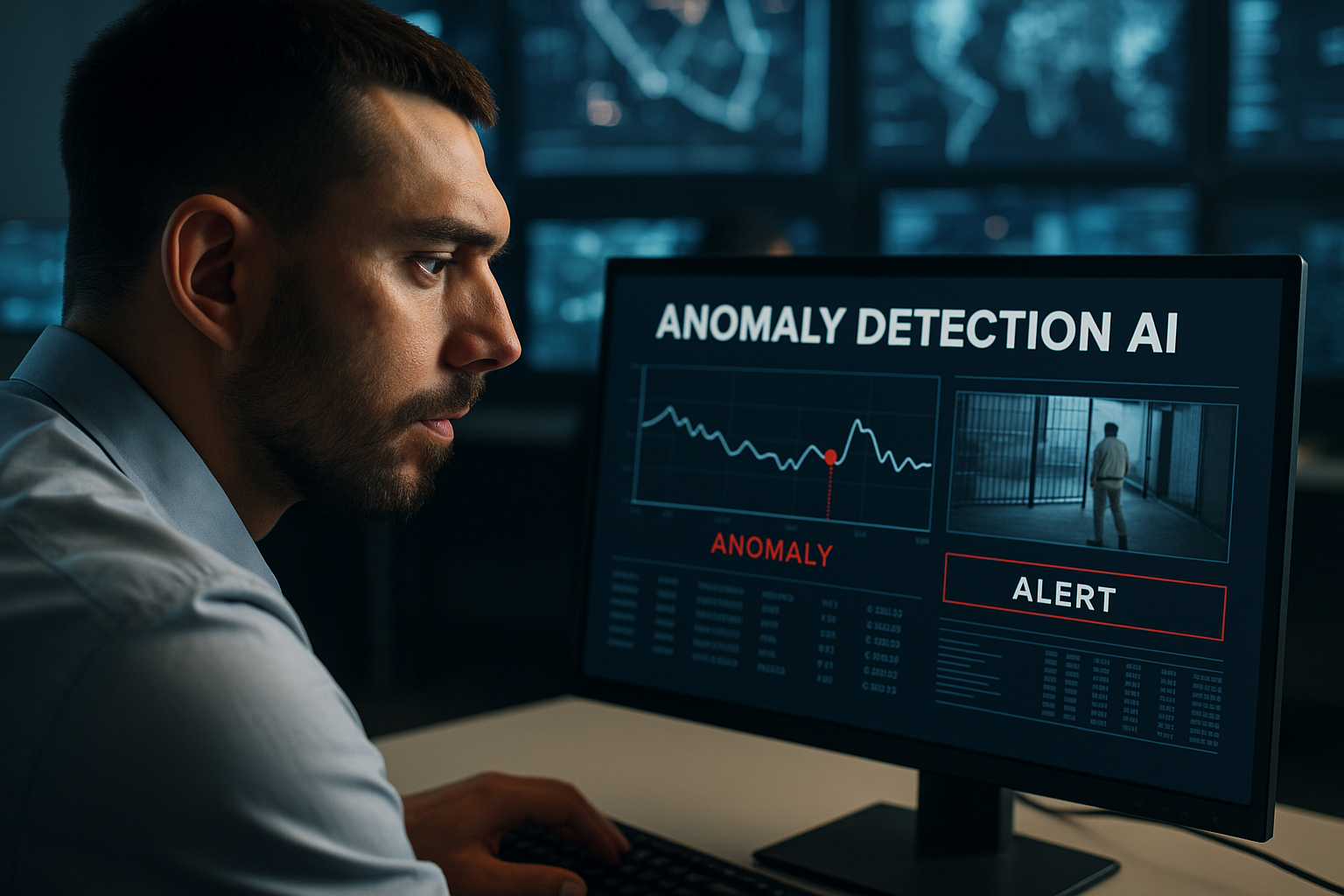Anomaly Detection in Modern Electoral Systems
by Daniyal Hassan, Last updated: June 5, 2025, Code:

Election integrity is more critical and vulnerable than ever. This blog explores five ways anomaly detection enhances transparency in elections by identifying irregularities in real-time, automating alerts, ensuring unbiased oversight, and supporting secure audits. Learn how AI-powered systems can help safeguard democracy and restore public trust.
An election concludes, but instead of celebrations, chaos ensues. Headlines are flooded with accusations of fraud, public trust deteriorates, and the very foundation of democracy is shaken. The Heritage Foundation's Election Fraud Map highlights the unsettling reality that attempts to alter election outcomes are a genuine possibility.
This isn't just a scenario for election administrators, security professionals, and government officials, it’s their worst nightmare.
When elections lack transparency and fairness, the repercussions ripple far beyond politics. Public trust, governmental stability, and even national security are on the line, all of which underscore the urgent need for stronger safeguards.
As a result, the rise of artificial intelligence technology has heightened the potential for enhancing election security and the risks accompanying it.
In this context, anomaly detection emerges as a critical solution, bridging the gap between vulnerability and security. It ensures that every vote counts and every irregularity is caught, fostering trust in the democratic process.
The Election Dilemma
Elections are the cornerstone of democratic societies, symbolizing the people's voice and will. Yet, without robust safeguards, this foundation is vulnerable to manipulation and doubt.
The integrity of the electoral process is increasingly under threat.
Allegations of voter fraud, ballot tampering, and unauthorized access to polling stations all contribute to undermining public trust, with each perceived irregularity weakening the very principles democracy relies on.
The Scale of the Challenge
Managing an election is a herculean task. Consider the following:
Thousands of polling stations are spread across diverse geographies. Millions of ballots need accurate counting and verification. A constant influx of voter data requires secure handling.
Now, layer these challenges with a volatile socio-political climate. Any hiccup, whether real or perceived, can spark outrage.
Fraudulent ballots, missing votes, or unaccounted irregularities become headlines faster than officials can respond.
Moreover, election administrators are expected to handle these complexities with minimal errors, often under intense public and media scrutiny.
Yet traditional monitoring and security tools, while effective in their time, are ill-equipped to manage the nuances of modern elections.
This is where the dilemma lies: How do you maintain absolute transparency and fairness in such a high-stakes, high-pressure environment?
Consequences of Overlooking Risks
Failing to address these challenges comes with a steep price:
- Public Trust Erosion: The moment voters lose faith in the system, the democratic process becomes vulnerable to delegitimization.
- Legal Repercussions: Allegations of irregularities often lead to lawsuits, recounts, and drawn-out legal battles.
- Reputational Damage: Election officials and governments risk being branded as incompetent—or worse, complicit in fraudulent activities.
The consequences ripple far beyond the election itself, destabilizing political systems and potentially inciting civil unrest.
The need for a comprehensive, technology-driven solution has never been more urgent.
Why These Problems Are a Crisis
The problems outlined above don’t just represent operational challenges; they constitute a full-blown crisis for election integrity.
Here’s why:
The Fragility of Public Trust
Trust is difficult to build but easy to lose. In an era where misinformation spreads rapidly, even the smallest irregularity can quickly escalate into a major controversy.
A single incident, such as ballot tampering or unauthorized access at a polling station, can become the focal point of national outrage, regardless of its actual significance.
This is especially concerning given that, according to Pew Research, public trust in the government has been steadily increasing after years of decline.
Voters expect an election process that is not only fair but also appears to be fair. Any lapse in transparency, whether caused by negligence or intentional tampering, creates fertile ground for conspiracy theories.
Such incidents undermine public confidence, eroding trust in both the system and the leaders it upholds.
Increasingly Sophisticated Threats
The threats to election processes have evolved. It’s no longer just about physical tampering at polling stations. Cyber threats, data breaches, and insider attacks are now part of the equation. For example:
Hackers could target electronic voting machines to manipulate results.
Insider threats could compromise sensitive voter information.
Coordinated disinformation campaigns could exploit minor irregularities to question election outcomes.
Traditional safeguards, like manual audits or static surveillance, cannot keep pace with these sophisticated threats. This leaves critical gaps in the system, inviting exploitation.
Mounting Operational Complexity
Modern elections are sprawling, multifaceted operations involving:
- High volumes of data from voter registrations, electronic voting machines, and poll monitoring systems.
- Coordination across multiple stakeholders, including election officials, security personnel, and IT teams.
- High-pressure timelines where delays or errors are unacceptable.
In such a dynamic environment, even small-scale human errors—like misplacing ballots or incorrectly logging voter data—can snowball into major controversies.
The Potential for Civil Unrest
Elections are emotionally charged events. When people feel their votes don’t count or the process is compromised, anger and frustration can quickly escalate into public demonstrations, or worse, violent unrest.
History has shown how disputed elections can destabilize governments and even spark nationwide chaos.
For example, A mismatch in vote tallies could lead to allegations of fraud, fueling protests.
A security breach at a polling station could lead to accusations of insider collusion, triggering widespread outrage.
Election officials are not just safeguarding ballots; they’re safeguarding public order.
Accountability in the Digital Age
Today’s voters demand more accountability than ever before. Social media platforms amplify every issue, with incidents going viral within minutes.
Election officials must respond to these challenges in real-time while ensuring the integrity of the process.
The pressure to maintain transparency and provide instant answers is immense. Without the right tools, managing this level of accountability is nearly impossible, leaving officials exposed to scrutiny and criticism.
The Urgent Need for Enhanced Election Security
These problems don’t just call for incremental improvements—they demand a fundamental shift in monitoring and securing elections. This is where anomaly detection comes in.
By leveraging advanced algorithms and real-time data analysis, anomaly detection offers a scalable, reliable, and proactive solution to address these challenges head-on.
The question isn’t whether to adopt this technology, it’s how quickly you can implement it to protect the credibility of your elections.
How Anomaly Detection Ensures Transparency and Fairness
Anomaly detection leverages advanced algorithms, machine learning, and data analytics to identify irregularities in real-time.
Let’s explore how it addresses the core challenges of election integrity.
1. Real-Time Monitoring of Polling Stations
Anomaly detection leverages advanced algorithms to monitor video feeds, elections live streaming, sensor data, and other inputs in real-time.
Unlike traditional systems, it doesn’t wait for humans to spot issues—it flags irregularities the moment they occur. Examples of anomalies that these systems can identify include:
- Tampering with Ballot Boxes or Voting Machines: If someone attempts to access a ballot box without authorization or manipulates voting equipment, the system detects the action instantly and generates an alert.
- Unauthorized Access: Doors or restricted areas that require specific credentials can be monitored for suspicious access attempts, ensuring only authorized personnel can enter.
- Unusual Crowd Behavior: The system detects abnormalities in crowd size, movement patterns, or gatherings that deviate from the norm. For instance, a sudden gathering outside a polling station might indicate an organized protest or potential disruption.
- Unattended or Suspicious Objects: Left-behind objects like bags near polling stations could indicate a security threat. The system analyzes the scene and raises alarms accordingly.
Human security officers can miss these irregularities, especially during busy periods. By automating anomaly detection, governments can ensure that nothing, no matter how subtle, slips through the cracks.
2. Automated Alerts for Faster Response
In high-pressure situations like elections, time is everything. Anomaly detection systems don’t just flag irregularities—they take the next step by generating instant, automated alerts. These alerts can be sent directly to:
- Security officers on the ground can respond immediately.
- Central monitoring teams ensure a coordinated response.
- Election officials, so they’re kept in the loop about potential issues.
These alerts are highly customizable. For instance:
- Minor Incidents: Alerts about minor anomalies, such as an unattended object, might be sent to local security staff only.
- Major Breaches: Alerts about tampering or unauthorized access can trigger a chain of escalation, notifying senior officials and activating additional resources.
3. Unbiased Monitoring
Unlike human monitors, AI-powered anomaly detection systems are free from bias, fatigue, or distraction.
This ensures consistent, reliable monitoring throughout the election process, regardless of scale or complexity.
- No Cognitive Bias: The system doesn’t make assumptions based on previous experiences or personal judgment—it evaluates every situation solely on data and pre-set parameters.
- Vigilance: Fatigue and distraction are non-issues for AI. The system operates tirelessly, monitoring feeds and analyzing data without breaks or errors.
4. Seamless Integration with Existing Systems
One of the biggest hurdles for government agencies when adopting new technology is the fear of costly and complex overhauls.
Anomaly detection technology removes this barrier by integrating seamlessly with existing infrastructure.
- Works with Current CCTV/IP Cameras: You don’t need to replace your surveillance hardware. Anomaly detection software works with existing cameras and networks, leveraging them to enhance monitoring capabilities.
- Customizable to Fit Unique Requirements: The system can be tailored to fit the specific needs of different polling stations, whether monitoring outdoor areas, detecting tampering with electronic voting machines, or analyzing crowd patterns.
- Minimal Downtime: Installation and integration are designed to be quick and efficient, ensuring minimal disruption to ongoing operations.
5. Data-Driven Auditing
Transparency doesn’t end when the polls close. Election audits are an essential part of the process, and anomaly detection systems make them faster, more reliable, and more transparent.
The system records every anomaly detected during the election, along with:
- Time-stamped logs for each incident.
- Video footage and supporting data as evidence.
- A detailed summary of actions taken in response to the anomaly.
These records are stored securely, ensuring that oversight bodies and auditors have access to verifiable, tamper-proof data.
During a post-election audit, an oversight body investigates claims of unauthorized access at a polling station.
Using the system’s logs and video evidence, they confirm that no breach occurred, effectively dispelling doubts about the station’s integrity.
Strengthening Election Transparency with Anomaly Detection
Anomaly detection has emerged as a powerful solution for enhancing election transparency and preventing irregularities.
By monitoring polling stations in real time and generating automated alerts, election officials can respond instantly to potential risks. Unlike traditional methods, anomaly detection ensures no suspicious activity goes unnoticed.
Its ability to deliver unbiased monitoring, seamless integration, and detailed audit trails makes it ideal for governments and agencies aiming to uphold the integrity of their electoral processes.
With election fraud prevention and public trust at stake, investing in AI-powered anomaly detection is not just smart, it’s essential.
Want to explore how anomaly detection can support your election monitoring needs? Start your Free Trial or Explore our AI Services to discover how VIDIZMO can help secure your democratic processes.
People Also Ask
What is anomaly detection in election monitoring?
Anomaly detection in election monitoring uses artificial intelligence to automatically identify irregularities in processes such as voter behavior, access control, and voting patterns. It ensures real-time alerts for potential threats, boosting election transparency and fairness.
How does anomaly detection improve election transparency?
Anomaly detection improves transparency by continuously analyzing data and instantly flagging suspicious activities. This ensures irregularities are quickly addressed and publicly auditable, fostering trust in the election process.
Can anomaly detection prevent voter fraud?
Anomaly detection cannot prevent fraud completely, but it plays a major role in identifying potential fraudulent activities early. This enables authorities to intervene promptly and mitigate the risks of tampering or manipulation.
Why is anomaly detection important in modern elections?
Anomaly detection is vital in modern elections because it provides scalable, unbiased, and real-time monitoring across digital and physical systems. This helps address increasingly sophisticated threats like cyberattacks and insider interference.
Is anomaly detection technology scalable for national elections?
Yes, anomaly detection systems are designed to scale across thousands of polling locations. They can handle large datasets, integrate with existing surveillance infrastructure, and deliver consistent monitoring at national or regional levels.
How does anomaly detection ensure unbiased election monitoring?
Anomaly detection uses predefined logic and machine learning models to detect unusual patterns without human biases. This eliminates inconsistencies caused by fatigue, assumptions, or human error.
Can anomaly detection integrate with existing election systems?
Yes. Anomaly detection tools can be deployed with current surveillance systems like CCTV and polling software, allowing for seamless integration and minimal operational disruption during implementation.
What kind of anomalies can be detected in polling stations?
Systems can detect unauthorized access, tampering with voting machines, unattended objects, abnormal crowd behavior, and other irregularities, ensuring comprehensive coverage of physical and digital threats.
How does anomaly detection support post-election audits?
Anomaly detection creates detailed logs and captures video evidence of any flagged incidents. These records can be reviewed during audits to validate claims, offering tamper-proof transparency and accountability.
Is anomaly detection effective for small-scale elections or local voting?
Yes. Anomaly detection can be adapted for small-scale elections by customizing alert thresholds and monitoring parameters. It helps smaller jurisdictions maintain high standards of security and integrity.
Jump to
You May Also Like
These Related Stories

Respond Swiftly to Potential Fire Hazards with Anomaly Detection

How AI-powered Anomaly Detection Helps Organizations Stay Secure and Compliant
.jpg)

No Comments Yet
Let us know what you think